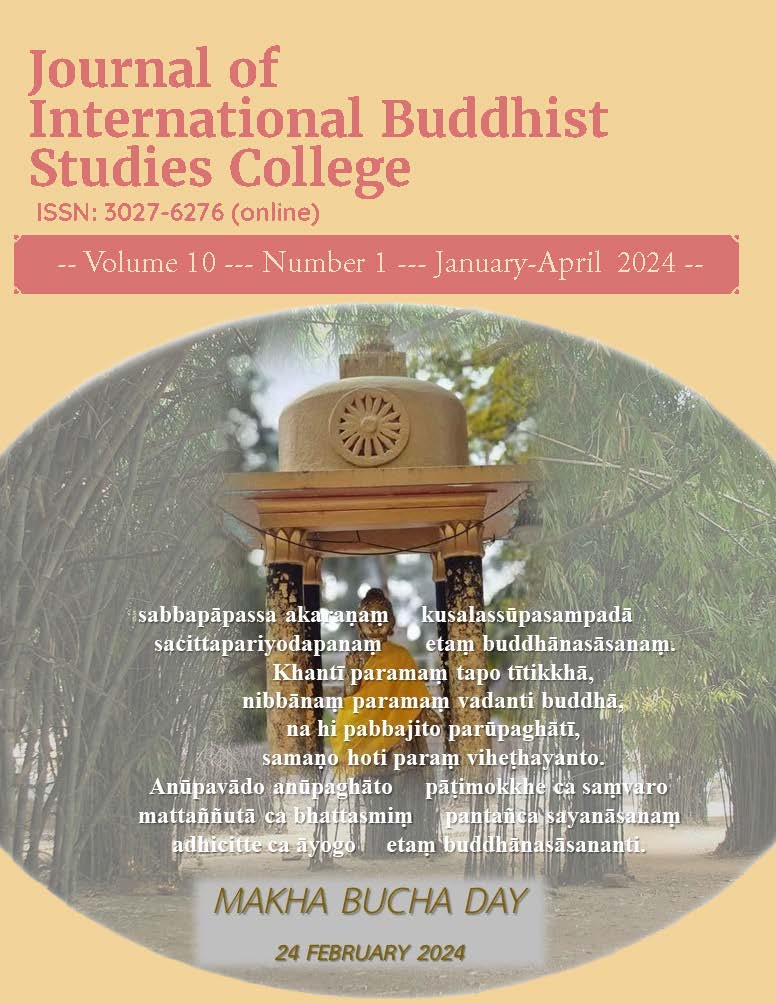Finding Peaceful Living Through the Pa-Auk or Ledi Meditation Techniques
Main Article Content
Abstract
This article thoroughly examines the shared foundational principles that are deeply ingrained in Buddhist teachings and are embodied by both the Pa-Auk and Ledi meditation techniques. It emphasizes the importance of mindfulness, concentration, and insight as crucial elements that lead to inner peace and spiritual liberation. In the process of exploring the role of meditation in fostering a peaceful existence, it brings to light how the Pa-Auk and Ledi techniques, which are part of the Theravada Buddhism tradition, offer distinct paths for individuals to discover themselves and develop personally. The Pa-Auk meditation technique focuses on the cultivation of tranquility (samatha) and insight (vipassana) through various practices such as breath awareness and mindfulness of physical sensations. Practitioners of this technique benefit from the guidance provided by the teachings of the Buddha as well as contemporary masters, which aids them in making spiritual progress and living harmoniously. On the other hand, the Ledi meditation method, which was developed by the Burmese monk Ledi Sayadaw, places its emphasis on the mindfulness of the body by systematically reflecting on bodily sensations and breath awareness. The aim of this approach is to shed light on the impermanent nature of existence, thereby fostering a deep understanding of the transient nature of the world. Both techniques bring about serene advantages, with the Pa-Auk meditation technique promoting emotional balance, peaceful coexistence, and a more profound understanding of existential realities. Similarly, the Ledi meditation technique emphasizes the cultivation of mindfulness, concentration, and understanding, ultimately leading to the cessation of suffering and the attainment of a peaceful way of living. By embracing both the Pa-Auk and Ledi meditation practices, individuals embark on a transformative journey towards heightened self-awareness, compassion, and alignment with their surroundings, ultimately contributing to the creation of a tranquil society characterized by harmony and peaceful cohabitation.
Article Details
The Journal of TCI is licensed under a Creative Commons Attribution-NonCommercial-NoDerivatives 4.0 International (CC BY-NC-ND 4.0) licence unless otherwise stated. Please read our Policies page for more information on Open Access, copyright and permissions.
References
Bradley, C. (2023, April 3). Stabilize Your Body and Mind. Mindful Meditation. https://www.mindful.org/stabilize-your-body-and-mind/.
Buddhadasa, Bhikkhu & Nagasena Bhikkhu. (1980). Anapanasati: Mindfulness of Breathing. (1st ed. Vol. I, II, III.) Sublime Life Mission.
Davids, T. W. Rhys. (1961). The Dīgha – Nikāya. Vol II. Luzac & Company.
Davids, T. W. Rhys. (2000). The Mijjima – Nikāya. Vol I, III. Luzac & Company.
Jotika, U., & Dhamminda, U. (trans.) (1986). Mahāsatipatthana Sutta: The Greater Discourse on Steadfast Mindfulness. Migadavun Monastery.
Kane, Ryan. (2023). What is the Goal of Meditation? Mindfulness box. https://mindfulnessbox.com/what-is-the-goal-of-meditation/
Mahthera Ledi Sayadaw. (2004). Manual of Mindfulness of Breathing, (Ānāpāna Dīpanī). Department of Religious Affairs
Mindworks Team. (2023). What is the Goal of Meditation? Mindworks Team. https://mindworks.org/blog/what-is-the-goal-of-meditation/
Moneyya Bhikkhu. (2016). Teaching & Training - Pa-Auk Forest Monastery. Pa-Auk Meditation Centre.
Nyanissara, V. A. (2022). A Short Biography of the Venerable Ledi Sayādaw. Pariyatti.
Sayadaw Ledi. Manual of Buddhism. (1988). The Exposition of the Buddha-Dhamma. The English Editorial Board (trs.). Department of Religious Affairs.
Pa-Auk Tawya Sayadaw. (2019). Knowing and seeing. (5th ed.) Pa-Auk Tawya Meditation Centre.
Pa-Auk Tawya Sayadaw. (2013). Mindfulness of Breathing, (2nd ed.) Pa-Auk Meditation Centre.
Sutton, Jeremy. (2023, May 4). 20+ Health Benefits of Meditation According to Science. Positive Psychology for Organizations. https://positivepsychology.com/benefits-of-meditation /#meditation
Thynn, T. (1995). Living Meditation, Living Insight: The path of mindfulness in daily life. The Dhamma Dana Publication.


